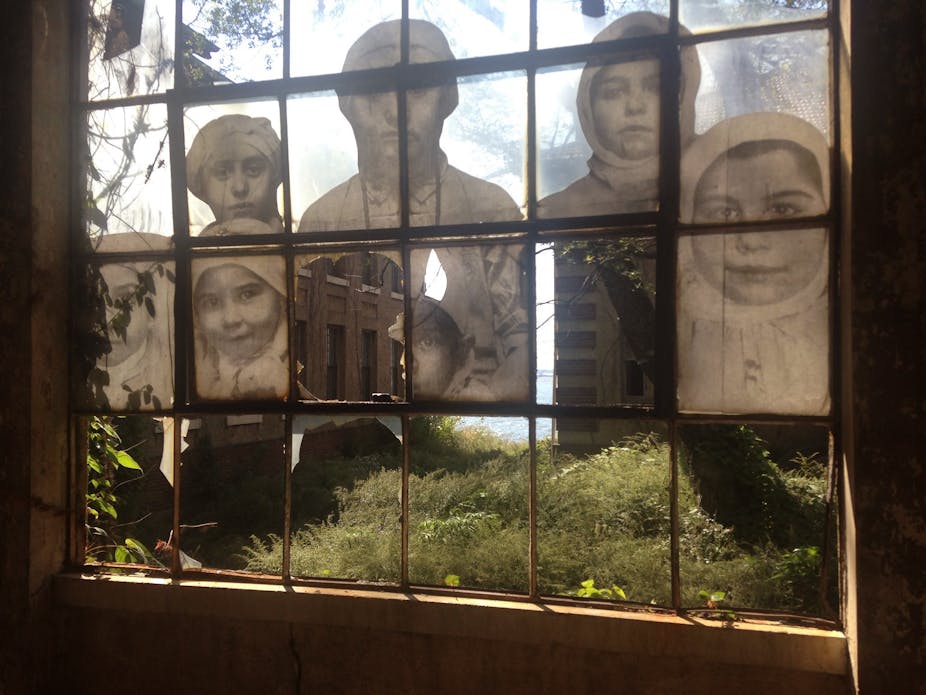This fall, French street artist JR and American cinematographer Bradford Young each installed a series of portraits in crumbling New York buildings. The two projects were not coordinated, but together they raise questions about the strange allure of dilapidated property. While the content of the installations is certainly worth sustained contemplation, it was the artists’ choice of sites that captured my attention.

JR’s Unframed installation at Ellis Island is sparse, fashionably ecological, maybe even beautiful. He has pasted large-scale archival photographs of turn-of-the-century immigrants here and there throughout the island’s abandoned hospital.
The fading images, designed to disintegrate like the buildings themselves, infuse the landscape with a faint hint of human presence. At times the figures appear on windows, filtering the sunlight, framed by the lush, overgrown green and sparkling blue beyond. Sometimes they’re in stairwells or plastered on old filing cabinets.

Bradford Young’s Bynum Cutler installation in the old PS 83 school building in Brooklyn features giant, close-cropped video portraits of elders from the Bethel Tabernacle AME Church in Bedford-Stuyvesant. The church owns the building, and for a few years in the 1980s, the congregation used this space for worship. Like JR, Young arranged his portraits in an abandoned building, but this one is boarded up; inside it’s dark.
A cool white glow emanates from projection screens, falling softly on a row of church pews. Silhouetted visitors float into the space, encountering the portraits for a few moments, then float out again past the dusty altar, as if carried by the overpowering, ethereal soundscape furnished by composer Gingger Shankar.

Both installations trade on a fascination with structural decay — perhaps rooted in a natural curiosity about urban abandonment. But in some ways, the buildings are like the reclaimed wood dining tables and industrial-era typography that appear in home furnishing catalogs. As objects, they become symbols of sophisticated consumer taste.

In fact it’s hard not to see the two exhibits as a metaphor for the nation’s underfunded cities. A public hospital on Ellis Island and a public school in Brooklyn: both buildings were constructed with taxpayers’ money over a hundred years ago. They offer evidence of a profound economic investment in a robust and healthy industrial workforce.
Now within these ruins, visitors survey the material traces of values that are dilapidated and decaying too. In today’s global, flexible economy, the state is not as concerned with the development of a robust and healthy workforce. Rather, as individuals, we are expected to take responsibility for our own lives.
In fact, when entering these buildings, the mostly middle-and-upper-class tourists sign liability waivers, assuming personal responsibility for their own health and well-being. Then they embark on tours of the past — tours of a moment in which such responsibilities were not left to individuals, but rather shared by the public.
The installations transform the two buildings — constructed as real, material resources — into cultural resources. A robust public sector once generated economic capital for the nation. But now the school and hospital are access points for cultural capital.
Visitors experience these sites not to receive medical attention or an education, but rather to engage in an abstract exchange: one that is less material, more about intellect and taste. The installations confer a kind of status on visitors.

Their dissonant elegance evokes emotion, but the sites remain mute witnesses to history. Instead of focusing our attention on communities deprived of basic resources, the buildings look as if they’re just trash, waiting for someone to come along and innocently recycle them into something more beautiful — and consumable.

JR says his work is about “raising questions” and the two installations certainly do that. Why were these buildings abandoned? Who owns these once-public resources? As private developers buy and repurpose civic structures for private use, it’s worth considering the people who need public schools and hospitals (and don’t need luxury condos). How might a deeper understanding of urban abandonment help us address the challenges facing cities today: gentrification, racial segregation, underfunded schools?
These artists bring the melancholy of abandonment to the surface. What can we make of that melancholy and our fascination with it? How can we channel it? Or would we rather just take a picture?

